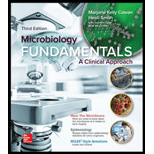
Microbiology Fundamentals: A Clinical Approach
3rd Edition
ISBN: 9781259709227
Author: Marjorie Kelly Cowan Professor, Heidi Smith
Publisher: McGraw-Hill Education
expand_more
expand_more
format_list_bulleted
Concept explainers
Question
Chapter 2.2, Problem 6AYP
Summary Introduction
To describe:
Three features of good microscopy.
Concept introduction:
When a specimen is placed under the microscopes then two types of images are produced by the lenses of the microscopes, these images are real image and the virtual image. The various characteristics of the microscopes are responsible for the formation of the images. The real image is produced by the objective lens and avirtual image is an enlarged form of real image produced by the ocular lens.
Expert Solution & Answer
Want to see the full answer?
Check out a sample textbook solution
Students have asked these similar questions
Please draw in the missing answer, thank you
Please fill in all blank questions, Thank you
please fill in missing parts , thank you
Chapter 2 Solutions
Microbiology Fundamentals: A Clinical Approach
Ch. 2.1 - Explain what the Five Is are and what each step...Ch. 2.1 - Discuss three physical states of media and when...Ch. 2.1 - Compare and contrast selective and differential...Ch. 2.1 - Provide brief definitions for defined media and...Ch. 2.1 - Medical Moment The Making of the Flu Vaccine: An...Ch. 2.1 - Prob. 1NPCh. 2.1 - Prob. 2NPCh. 2.2 - Prob. 5AYPCh. 2.2 - Prob. 6AYPCh. 2.2 - Prob. 7AYP
Ch. 2.2 - Give examples of simple, differential, and special...Ch. 2.2 - Prob. 3NPCh. 2.2 - Medical Moment Gram-Positive Versus Gram-Negative...Ch. 2 - The identities of microorganisms on our planet a....Ch. 2 - Prob. 2QCh. 2 - Often bacteria that are freshly isolated from a...Ch. 2 - Which of these types of organisms is least likely...Ch. 2 - Prob. 5QCh. 2 - Some bacteria can produce a structure called an...Ch. 2 - A fastidious organism must be grown on what type...Ch. 2 - Write a short paragraph to differentiate among the...Ch. 2 - Prob. 9QCh. 2 - Viruses are commonly grown in/on a. animal cells...Ch. 2 - Can you devise a growth medium with ingredients...Ch. 2 - There is a type of differential medium that can...Ch. 2 - Prob. 13QCh. 2 - Several bacteria live naturally in a material on...Ch. 2 - Archaea often grow naturally in extreme...Ch. 2 - Prob. 16QCh. 2 - After performing the streak plate procedure on a...Ch. 2 - You are a scientist studying a marsh area...Ch. 2 - Prob. 19QCh. 2 - Prob. 20QCh. 2 - You perform the special stain for bacterial...Ch. 2 - Prob. 1VC
Knowledge Booster
Learn more about
Need a deep-dive on the concept behind this application? Look no further. Learn more about this topic, biology and related others by exploring similar questions and additional content below.Similar questions
- please draw in the answers, thank youarrow_forwarda. On this first grid, assume that the DNA and RNA templates are read left to right. DNA DNA mRNA codon tRNA anticodon polypeptide _strand strand C с A T G A U G C A TRP b. Now do this AGAIN assuming that the DNA and RNA templates are read right to left. DNA DNA strand strand C mRNA codon tRNA anticodon polypeptide 0 A T G A U G с A TRParrow_forwardplease answer all question below with the following answer choice, thank you!arrow_forward
- please draw in the answeres, thank youarrow_forwardA) What is being shown here?B) What is indicated by the RED arrow?C) What is indicated by the BLUE arrow?arrow_forwardPlease identify the curve shown below. What does this curve represent? Please identify A, B, C, D, and E (the orange oval). What is occurring in these regions?arrow_forward
- Please identify the test shown here. 1) What is the test? 2) What does the test indicate? How is it performed? What is CX? 3) Why might the test be performed in a clinical setting? GEN CZ CX CPZ PTZ CACarrow_forwardDetermine how much ATP would a cell produce when using fermentation of a 50 mM glucose solution?arrow_forwardDetermine how much ATP would a cell produce when using aerobic respiration of a 7 mM glucose solution?arrow_forward
- Determine how much ATP would a cell produce when using aerobic respiration to degrade one small protein molecule into 12 molecules of malic acid, how many ATP would that cell make? Malic acid is an intermediate in the Krebs cycle. Assume there is no other carbon source and no acetyl-CoA.arrow_forwardIdentify each of the major endocrine glandsarrow_forwardCome up with a few questions and answers for umbrella species, keystone species, redunant species, and aquatic keystone speciesarrow_forward
arrow_back_ios
SEE MORE QUESTIONS
arrow_forward_ios
Recommended textbooks for you
 Principles Of Radiographic Imaging: An Art And A ...Health & NutritionISBN:9781337711067Author:Richard R. Carlton, Arlene M. Adler, Vesna BalacPublisher:Cengage Learning
Principles Of Radiographic Imaging: An Art And A ...Health & NutritionISBN:9781337711067Author:Richard R. Carlton, Arlene M. Adler, Vesna BalacPublisher:Cengage Learning Human Biology (MindTap Course List)BiologyISBN:9781305112100Author:Cecie Starr, Beverly McMillanPublisher:Cengage Learning
Human Biology (MindTap Course List)BiologyISBN:9781305112100Author:Cecie Starr, Beverly McMillanPublisher:Cengage Learning Comprehensive Medical Assisting: Administrative a...NursingISBN:9781305964792Author:Wilburta Q. Lindh, Carol D. Tamparo, Barbara M. Dahl, Julie Morris, Cindy CorreaPublisher:Cengage Learning
Comprehensive Medical Assisting: Administrative a...NursingISBN:9781305964792Author:Wilburta Q. Lindh, Carol D. Tamparo, Barbara M. Dahl, Julie Morris, Cindy CorreaPublisher:Cengage Learning


Principles Of Radiographic Imaging: An Art And A ...
Health & Nutrition
ISBN:9781337711067
Author:Richard R. Carlton, Arlene M. Adler, Vesna Balac
Publisher:Cengage Learning


Human Biology (MindTap Course List)
Biology
ISBN:9781305112100
Author:Cecie Starr, Beverly McMillan
Publisher:Cengage Learning

Comprehensive Medical Assisting: Administrative a...
Nursing
ISBN:9781305964792
Author:Wilburta Q. Lindh, Carol D. Tamparo, Barbara M. Dahl, Julie Morris, Cindy Correa
Publisher:Cengage Learning
